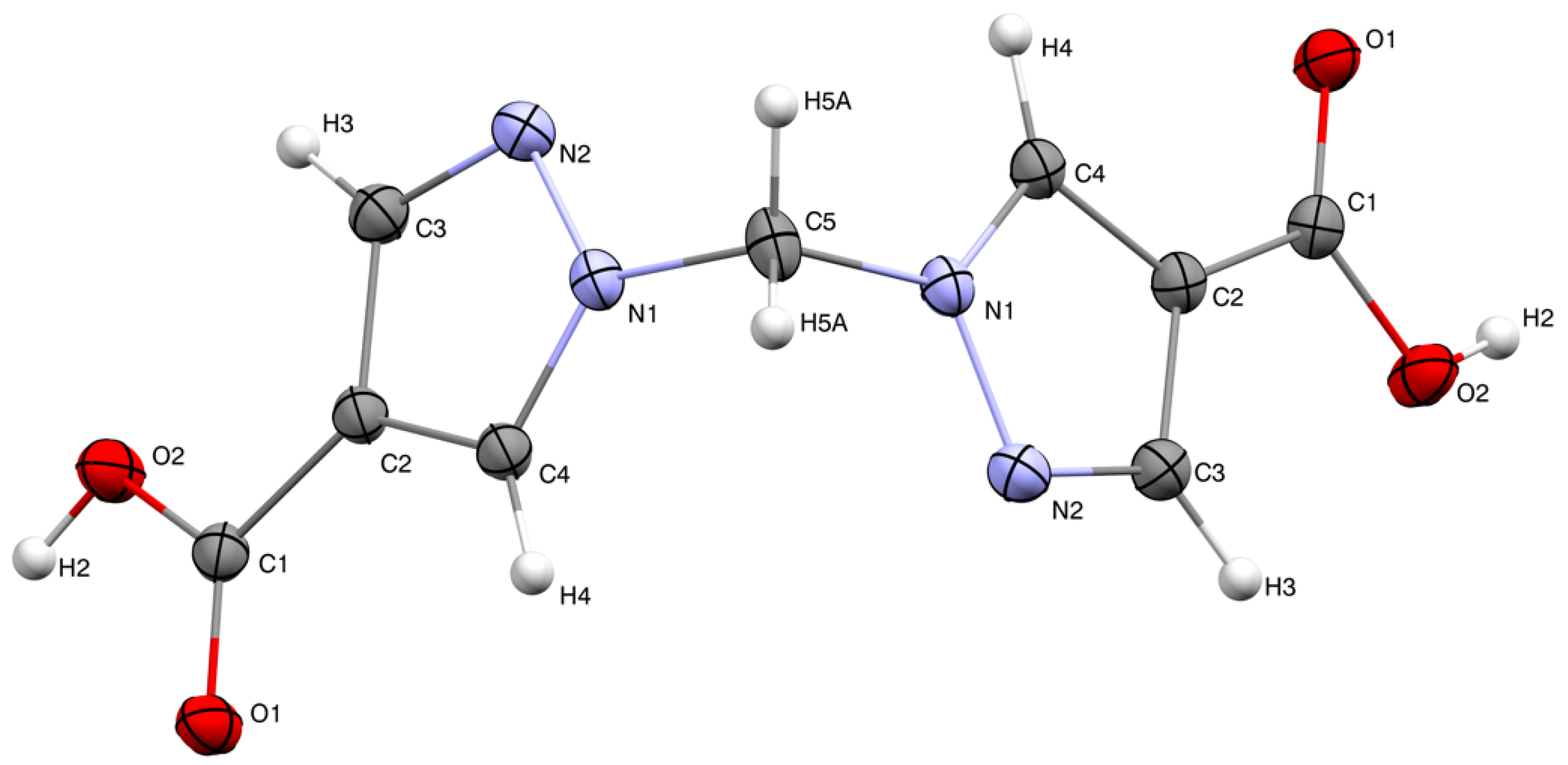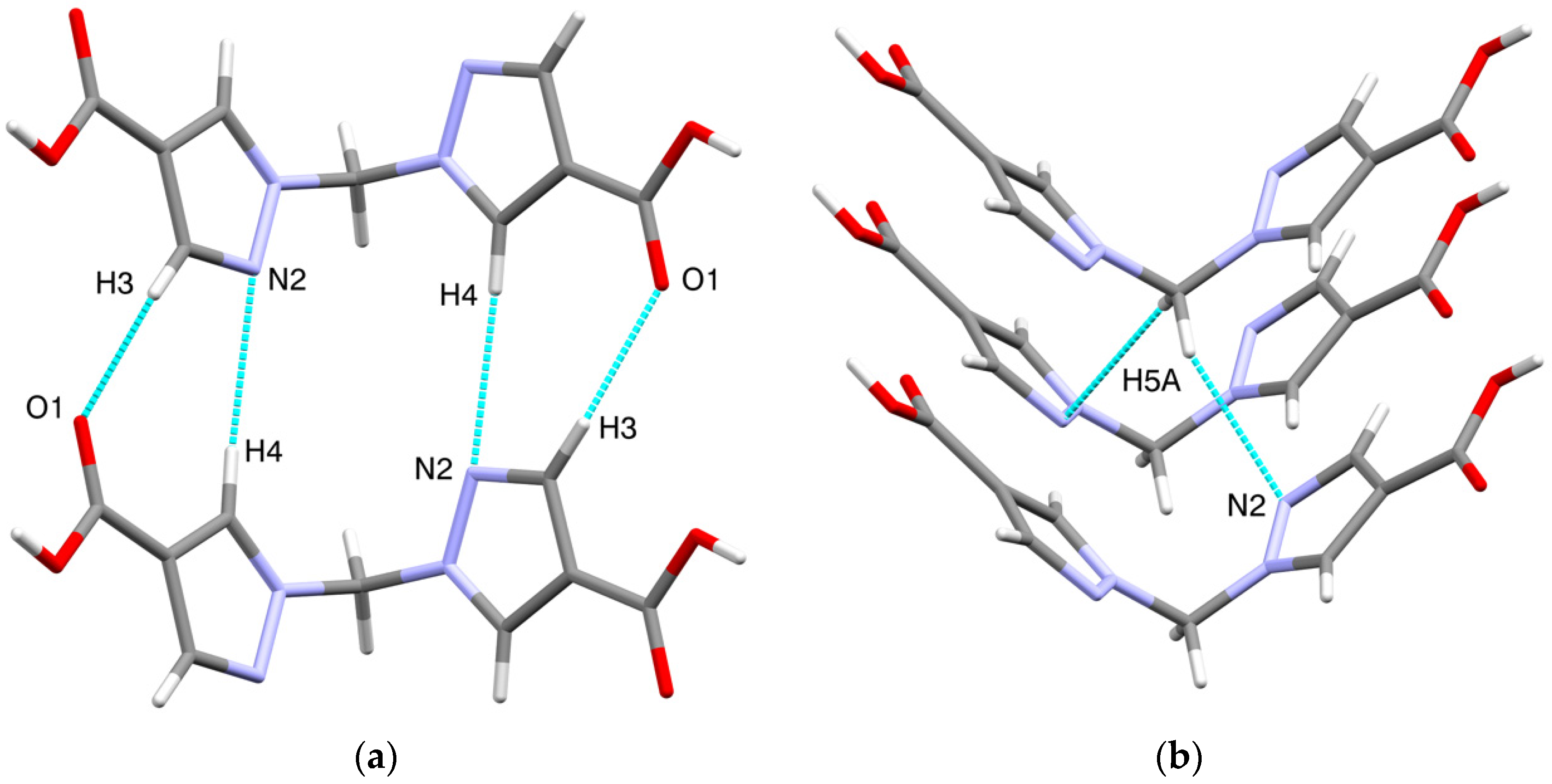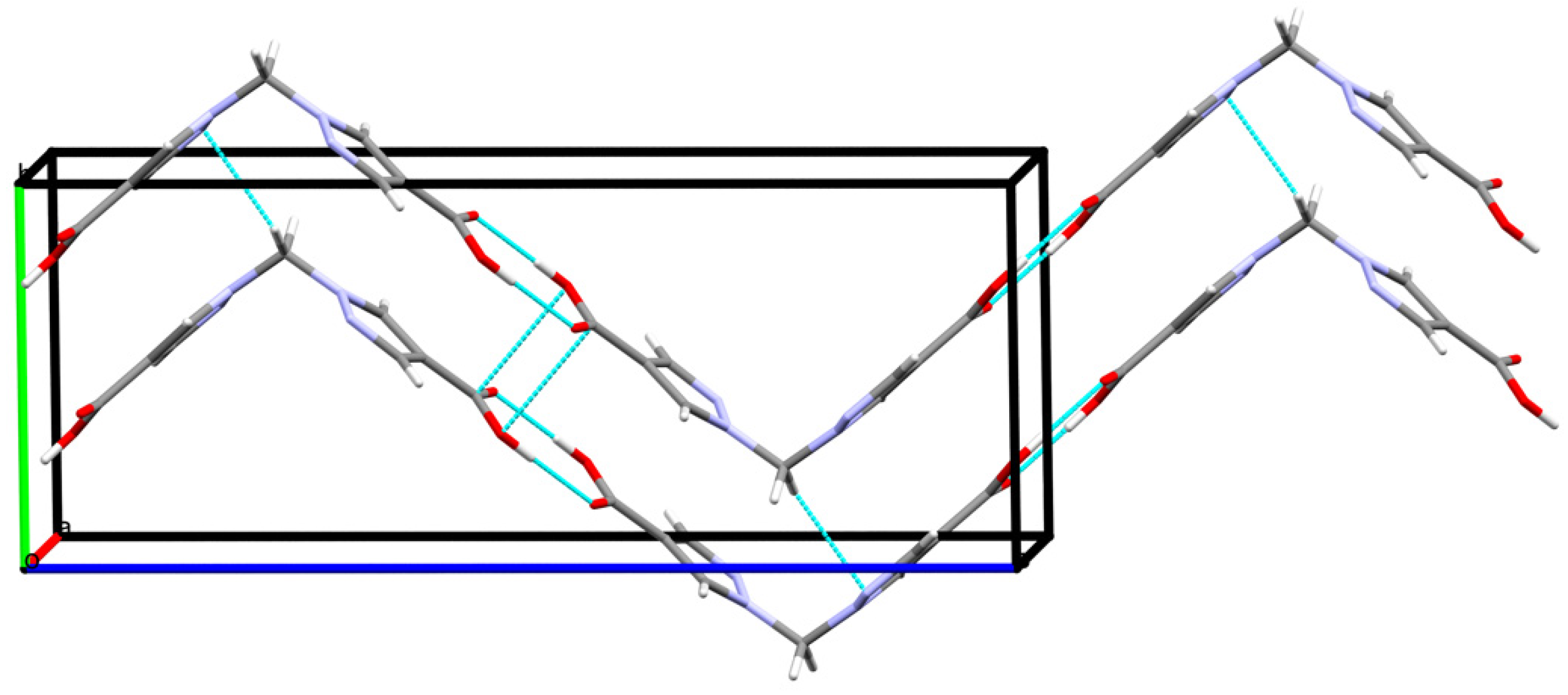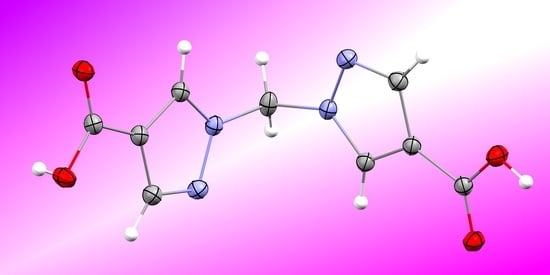Bis(pyrazol-1-yl)methane-4,4′-dicarboxylic Acid
Abstract
:1. Introduction
2. Results and Discussion
3. Materials and Methods
Supplementary Materials
Author Contributions
Funding
Institutional Review Board Statement
Informed Consent Statement
Data Availability Statement
Acknowledgments
Conflicts of Interest
References
- Hawes, C.S. Coordination sphere hydrogen bonding as a structural element in metal–organic Frameworks. Dalton Trans. 2021, 50, 6034–6049. [Google Scholar] [CrossRef] [PubMed]
- Butova, V.V.; Soldatov, M.A.; Guda, A.A.; Lomachenko, K.A.; Lamberti, C. Metal-organic frameworks: Structure, properties, synthesis and characterization. Russ. Chem. Rev. 2016, 85, 280–307. [Google Scholar] [CrossRef]
- Shi, Z.-Q.; Ji, N.-N.; Guo, K.-M.; Li, G. Crystalline hydrogen-bonded supramolecular frameworks (HSFs) as new class of proton conductive materials. Appl. Surf. Sci. 2020, 504, 144484. [Google Scholar] [CrossRef]
- Liao, L.; Zhong, X.; Jia, X.; Liao, C.; Zhong, J.; Ding, S.; Chen, C.; Hong, S.; Luo, X. Supramolecular organogels fabricated with dicarboxylic acids and primary alkyl amines: Controllable self-assembled structures. RSC Adv. 2020, 10, 29129–29138. [Google Scholar] [CrossRef]
- Hansen, B.B.; Spittle, S.; Chen, B.; Poe, D.; Zhang, Y.; Klein, J.M.; Horton, A.; Adhikari, L.; Zelovich, T.; Doherty, B.W.; et al. Deep Eutectic Solvents: A Review of Fundamentals and Applications. Chem. Rev. 2021, 121, 1232–1285. [Google Scholar] [CrossRef] [PubMed]
- Antipin, I.S.; Alfimov, M.V.; Arslanov, V.V.; Burilov, V.A.; Vatsadze, S.Z.; Voloshin, Y.Z.; Volcho, K.P.; Gorbatchuk, V.V.; Gorbunova, Y.G.; Gromov, S.P.; et al. Functional supramolecular systems: Design and applications. Russ. Chem. Rev. 2021, 90, 895–1107. [Google Scholar] [CrossRef]
- Röhm, S.; Schröder, M.; Dwyer, J.E.; Widdowson, C.S.; Chaikuad, A.; Berger, B.-T.; Joerger, A.C.; Krämer, A.; Harbig, J.; Dauch, D.; et al. Selective targeting of the αC and DFG-out pocket in p38 MAPK. Eur. J. Med. Chem. 2020, 208, 112721. [Google Scholar] [CrossRef] [PubMed]
- Dias, I.M.; Junior, H.C.S.; Costa, S.C.; Cardoso, C.M.; Cruz, A.G.B.; Santos, C.E.R.; Candela, D.R.S.; Soriano, S.; Marques, M.M.; Ferreira, G.B.; et al. Mononuclear coordination compounds containing a pyrazole-based ligand: Syntheses, magnetism and acetylcholinesterase inhibition assays. J. Mol. Struct. 2020, 1205, 127564. [Google Scholar] [CrossRef]
- Liu, Q.; Song, Y.; Ma, Y.; Zhou, Y.; Cong, H.; Wang, C.; Wu, J.; Hu, G.; O’Keeffe, M.; Deng, H. Mesoporous Cages in Chemically Robust MOFs Created by a Large Number of Vertices with Reduced Connectivity. J. Am. Chem. Soc. 2019, 141, 488–496. [Google Scholar] [CrossRef] [PubMed]
- Cheng, M.; Wang, Q.; Bao, J.; Wu, Y.; Sun, L.; Yang, B.; Liu, Q. Synthesis and structural diversity of d 10 metal coordination polymers constructed from new semi-rigid bis(3-methyl-1H-pyrazole-4-carboxylic acid)alkane ligands. New J. Chem. 2017, 41, 5151–5160. [Google Scholar] [CrossRef]
- Radi, S.; El-Massaoudi, M.; Benaissa, H.; Adarsh, N.N.; Ferbinteanu, M.; Devlin, E.; Sanakis, Y.; Garcia, Y. Crystal engineering of a series of complexes and coordination polymers based on pyrazole-carboxylic acid ligands. New J. Chem. 2017, 41, 8232–8241. [Google Scholar] [CrossRef]
- Kivi, C.E.; Gelfand, B.S.; Dureckova, H.; Ho, H.T.K.; Ma, C.; Shimizu, G.K.H.; Woo, T.K.; Song, D. 3D porous metal–organic framework for selective adsorption of methane over dinitrogen under ambient pressure. Chem. Commun. 2018, 54, 14104–14107. [Google Scholar] [CrossRef] [PubMed]
- Bloch, W.M.; Burgun, A.; Coghlan, C.J.; Lee, R.; Coote, M.L.; Doonan, C.J.; Sumby, C.J. Capturing snapshots of post-synthetic metallation chemistry in metal–organic frameworks. Nat. Chem. 2014, 6, 906. [Google Scholar] [CrossRef] [PubMed]
- Burgun, A.; Coghlan, C.J.; Huang, D.M.; Chen, W.; Horike, S.; Kitagawa, S.; Alvino, J.F.; Metha, G.F.; Sumby, C.J.; Doonan, C.J. Mapping-Out Catalytic Processes in a Metal-Organic Framework with Single-Crystal X-ray Crystallography. Angew. Chemie Int. Ed. 2017, 56, 8412–8416. [Google Scholar] [CrossRef] [PubMed] [Green Version]
- Burlutskiy, N.P.; Potapov, A.S. Approaches to the Synthesis of Dicarboxylic Derivatives of Bis(pyrazol-1-yl)alkanes. Molecules 2021, 26, 413. [Google Scholar] [CrossRef] [PubMed]
- D’Ascenzo, L.; Auffinger, P. A comprehensive classification and nomenclature of carboxyl-carboxyl(ate) supramolecular motifs and related catemers: Implications for biomolecular systems. Acta Crystallogr. Sect. B 2015, 71, 164–175. [Google Scholar] [CrossRef] [PubMed]
- Sheldrick, G.M. SHELXT—Integrated space-group and crystal-structure determination. Acta Crystallogr. Sect. A 2015, 71, 3–8. [Google Scholar] [CrossRef] [PubMed] [Green Version]
- Sheldrick, G.M. Crystal structure refinement with SHELXL. Acta Crystallogr. Sect. C 2015, 71, 3–8. [Google Scholar] [CrossRef] [PubMed]
- Dolomanov, O.V.; Bourhis, L.J.; Gildea, R.J.; Howard, J.A.K.; Puschmann, H. OLEX2: A complete structure solution, refinement and analysis program. J. Appl. Crystallogr. 2009, 42, 339–341. [Google Scholar] [CrossRef]





| Bond | d, Å | Angle | θ, ° |
|---|---|---|---|
| O1—C1 | 1.2280 (12) | C4—N1—N2 | 112.94 (8) |
| O2—C1 | 1.3187 (11) | C4—N1—C5 | 127.88 (7) |
| N1—C4 | 1.3500 (12) | N2—N1—C5 | 118.65 (7) |
| N1—N2 | 1.3683 (11) | C3—N2—N1 | 104.25 (8) |
| N1—C5 | 1.4497 (10) | O1—C1—O2 | 124.15 (9) |
| N2—C3 | 1.3267 (12) | O1—C1—C2 | 123.49 (9) |
| C1—C2 | 1.4627 (13) | O2—C1—C2 | 112.36 (8) |
| C2—C4 | 1.3830 (12) | C4—C2—C3 | 105.11 (8) |
| C2—C3 | 1.4150 (13) | C4—C2—C1 | 128.28 (9) |
| C3—C2—C1 | 126.59 (9) | ||
| N2—C3—C2 | 111.58 (8) | ||
| N1—C4—C2 | 106.10 (8) | ||
| N1i—C5—N1 | 111.34 (11) |
Publisher’s Note: MDPI stays neutral with regard to jurisdictional claims in published maps and institutional affiliations. |
© 2021 by the authors. Licensee MDPI, Basel, Switzerland. This article is an open access article distributed under the terms and conditions of the Creative Commons Attribution (CC BY) license (https://creativecommons.org/licenses/by/4.0/).
Share and Cite
Pershina, E.A.; Pavlov, D.I.; Burlutskiy, N.P.; Potapov, A.S. Bis(pyrazol-1-yl)methane-4,4′-dicarboxylic Acid. Molbank 2021, 2021, M1298. https://doi.org/10.3390/M1298
Pershina EA, Pavlov DI, Burlutskiy NP, Potapov AS. Bis(pyrazol-1-yl)methane-4,4′-dicarboxylic Acid. Molbank. 2021; 2021(4):M1298. https://doi.org/10.3390/M1298
Chicago/Turabian StylePershina, Elizaveta A., Dmitry I. Pavlov, Nikita P. Burlutskiy, and Andrei S. Potapov. 2021. "Bis(pyrazol-1-yl)methane-4,4′-dicarboxylic Acid" Molbank 2021, no. 4: M1298. https://doi.org/10.3390/M1298







